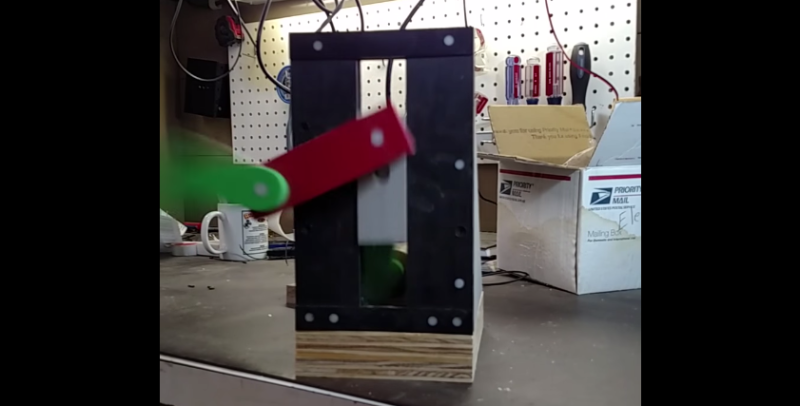If you’ve never seen a double pendulum before, it’s basically just a pendulum with another pendulum attached to the end. You might not think that’s anything special, but these devices can exhibit extremely chaotic behavior if enough energy is put into the system. The result is often a display that draws attention. [David] wanted to build his own double pendulum display, but he wanted to make it drive itself. The result is a powered double pendulum.
There aren’t many build details here, but the device is simple enough that we can deduce how it works from the demonstration video. It’s broken into two main pieces; the frame and the pendulum. The frame appears to be made mostly from wood. The front plate is made of three layers sandwiched together. A slot is cut out of the middle to allow a rail to slide up and down linearly. The rail is designed in such a way that it fits between the outer layers of the front plate like a track.
The pendulum is attached to the linear rail. The rail moves up and down and puts energy into the pendulum. This causes the pendulum to actually move and generate the chaotic behavior. The rail slides up and down thanks to an electric motor mounted to the base. The mechanics work similar to a piston on a crankshaft. The motor looks as though it is mounted to a wooden bracket that was cut with precision on a laser cutter. The final product works well, though it is a bit noisy. We also wonder if the system would be even more fun to watch if the rotation of the motor had an element of randomness added to it. Or he could always attach a paint sprayer to the end.
















You must watch to the end to get the full effect of this machine.. I wish the clip was a few seconds longer.
Sorry, I panicked and killed the video before it could walk off the table!
if it weren’t for you, I’d have miss the ending.
if it weren’t for your comment I’d have missed the ending.
Can I get featured on hackaday if I put a bowling ball in a washing machine?
This bowling ball in the washing machine exhibits chaotic behavior, the motor spins the rotor which then adds energy to the ball that goes round inside the machine whilst the exterior jumps about. The rotor is contained within the walls of the machine allowing it to stay in place. The final product works well, though it is a bit noisy. We also wonder if the system would be even more fun to watch if the rotation of the motor had an element of randomness added to it.
Only if your washing machine is controlled by an Arduino and has some 3D printed parts. Bonus points if you etched all the PCBs in your garage.
Please do it I would really enjoy watching it :D
Double points for making it a POV device.
What’s that I taste? Ahh. http://www.urbandictionary.com/define.php?term=Sour+Grapes
Add some rotary encoders, maybe throw in some light sensors on the base, do some whitening on the output, and BAM! You got yourself a (noisy) hardware RNG. I guess you could also just point a webcam at it…
It’s not chaotic behaviour at all, it’s totally ordered.
Deterministic chaos
That IS chaos. Well, deterministic from one step to the next, but with no way to predict any further down the line. That is, it’s impossible to predict stage N without running through all the intermediate stages first. Even though each stage is completely predictable from the one before it, and will always produce the same result.
It’s in between complete determinism, and randomness.
A++ totally agree. Really there is no such thing as 100% pure chaos. There is always predictability, ultimately. We’re simply fascinated with things that make it difficult to predict, and appear to be chaotic. We’re fascinated with the careful thought and precision that it takes to design and build a machine, and to watch it do its thing like this.
Nope, chaos is impossible to predict. Prove me wrong and win a Nobel prize, and probably a Fields medal.
Difference between chaos and randomness. Chaos equations are just nonlinear equations. Chaos is predictable if you know the initial conditions well enough, which is the problem.
Yea, I have to agree, it looks like crap for being a chaotic double pendulum. This on the other hand is an excellent piece of art and could be powered as well and it looks as it would be rather chaotic in the movements. https://www.youtube.com/watch?v=IP6f9r5MBWg
Reminds me of some physics engine games were you get that divide by zero error and things explode, bouncing off the screen boundaries.
You mean KSP?
“We also wonder if the system would be even more fun to watch” — you’re talking about pushing fun to it’s ultimate limits here. Such concepts are not to be trifled with, it’s like crossing the streams.
Put an LED on the front of each half of the pendulum and take a long-exposure photograph of it in the dark.
I really wish that NASA would fly one of these on the ISS so we could see what this does in the absence of gravity.
It be easy enough to simulate that in software.
Or flip the pendulum horizontally.
Woah woah woah, you’re telling me that gravity only pulls in one direction?!